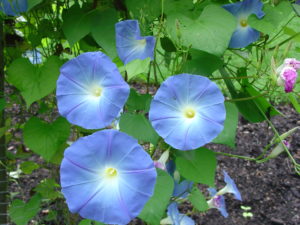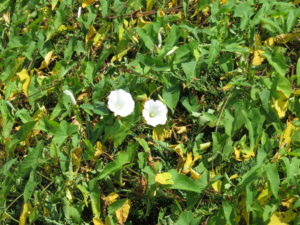Morning glory vines (Ipomoea tricolor) add a dash of old fashion charm to today’s gardens. YES! these aggressive vines demand a high degree of attention. Their funnel or tubular-shaped flowers open in the morning and close late in the afternoon. In a single growing season, vines may grow 6 to 12 feet and more (depending on variety). Morning glories will also aggressively self-seed.
Vines bloom non-stop from June to October. Flower colors are available in purple, blue, red, white, pink and bi-colors. Many gardeners opt to grow morning glory vines to cover trellises, pergolas, arches and fences. Grow some in hanging baskets and train vines to drape over the sides.
Morning glories are usually grown from seed and may be started indoors 4 – 6 weeks before the last spring frost. Where the growing season is long, direct seed into the garden or a large container after all threat of frost has passed. Select a site that gets plenty of sun. Morning glories prefer moderately fertile, well-drained soil that needs to be kept consistently moist until the vine(s) are well established. Morning glories bloom their best in full sun.
Soak the seeds for 24 hours prior to sowing to spur higher numbers and faster germination. Distribute the seeds and cover lightly with soil and water thoroughly. Irrigate every few days if rainfall is light. Some gardeners will pre-start the seeds in peat pots and transplant them after 4-6 weeks.
Fertilizing is usually not necessary. Feeding liquid fertilizer, such as Miracle-Gro or Jack’s monthly, will spur increased growth and flowering. Be careful… do not overfertilize as this can produce more foliage than flowers. To prevent unwanted self-seeding, old flowers should be completely removed before they form seed pods, an almost impossible task.
Morning glory vines are generally not troubled by diseases or pests. When not properly sited, they may be infected with fungal leaf spot, rust, and wilt diseases. Aphids, leaf miner, spider mites and caterpillars may also pop up. Deer will browse on the leaves and vines. The seeds are poisonous.
Morning glories are often mistaken for their weedy white blooming cousin, field bindweed (Convolvulus arvensis), also called Creeping Jenny. Field bindweed, a hardy perennial vine, spreads by deep roots and is nearly impossible to get rid of. Its deep winter hardy roots allow bindweed to overwinter in colder climates to return again and again. Field bindweed blooms either white or pink flowers; the flowers and leaves are smaller than morning glory.



 Posted in
Posted in 
